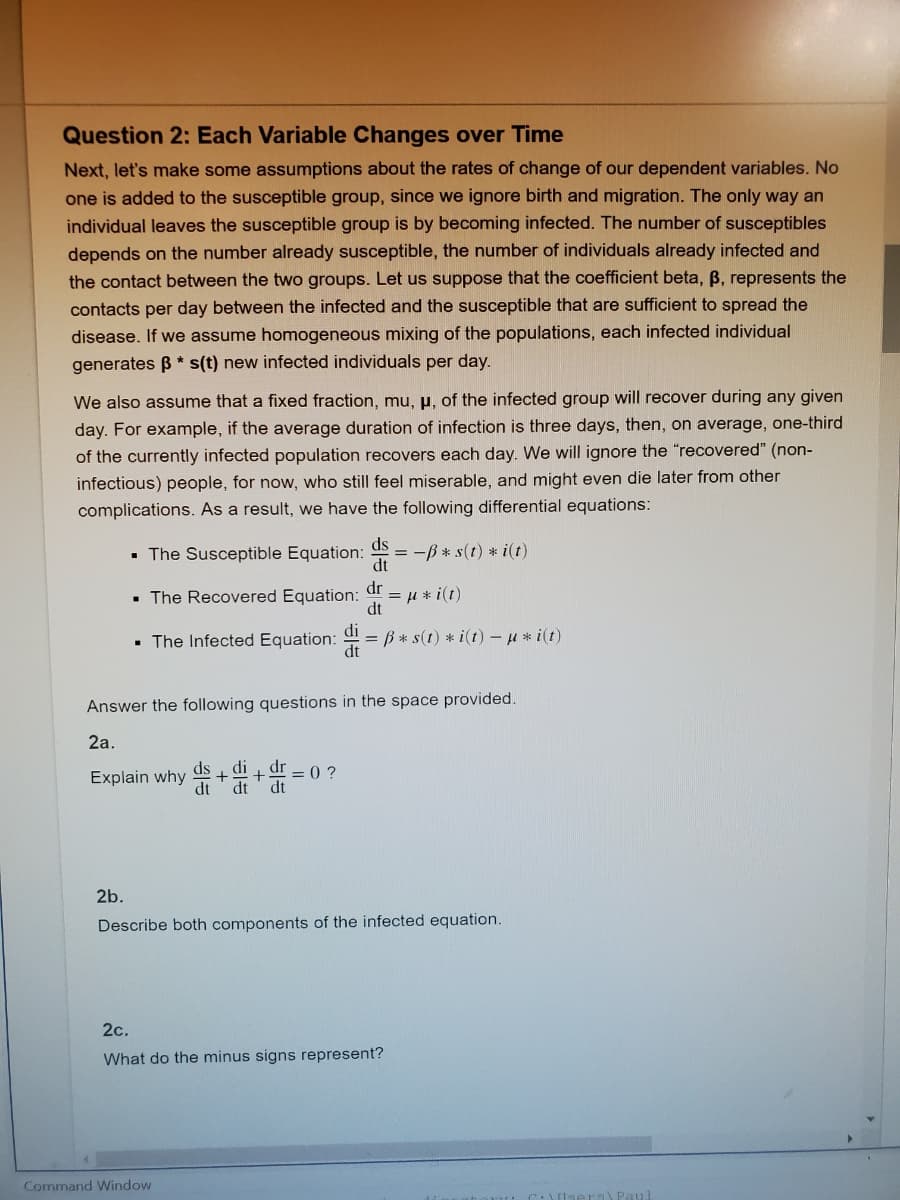Question 2: Each Variable Changes over Time Next, let's make some assumptions about the rates of change of our dependent variables. No one is added to the susceptible group, since we ignore birth and migration. The only way an individual leaves the susceptible group is by becoming infected. The number of susceptibles depends on the number already susceptible, the number of individuals already infected and the contact between the two groups. Let us suppose that the coefficient beta, B, represents the contacts per day between the infected and the susceptible that are sufficient to spread the disease. If we assume homogeneous mixing of the populations, each infected individual generates B * s(t) new infected individuals per day. We also assume that a fixed fraction, mu, µ, of the infected group will recover during any given day. For example, if the average duration of infection is three days, then, on average, one-third of the currently infected population recovers each day. We will ignore the "recovered" (non- infectious) people, for now, who still feel miserable, and might even die later from other complications. As a result, we have the following differential equations: • The Susceptible Equation: ds = -ß * s(t) * i(t) dt • The Recovered Equation: dr = u * i(t) dt • The Infected Equation: di = B * s(1) * i(t) – µ * i(t) dt Answer the following questions in the space provided. 2a. di ds Explain why dt + af = 0 ? dt dt 2b. Describe both components of the infected equation. 2c. What do the minus signs represent?
Question 2: Each Variable Changes over Time Next, let's make some assumptions about the rates of change of our dependent variables. No one is added to the susceptible group, since we ignore birth and migration. The only way an individual leaves the susceptible group is by becoming infected. The number of susceptibles depends on the number already susceptible, the number of individuals already infected and the contact between the two groups. Let us suppose that the coefficient beta, B, represents the contacts per day between the infected and the susceptible that are sufficient to spread the disease. If we assume homogeneous mixing of the populations, each infected individual generates B * s(t) new infected individuals per day. We also assume that a fixed fraction, mu, µ, of the infected group will recover during any given day. For example, if the average duration of infection is three days, then, on average, one-third of the currently infected population recovers each day. We will ignore the "recovered" (non- infectious) people, for now, who still feel miserable, and might even die later from other complications. As a result, we have the following differential equations: • The Susceptible Equation: ds = -ß * s(t) * i(t) dt • The Recovered Equation: dr = u * i(t) dt • The Infected Equation: di = B * s(1) * i(t) – µ * i(t) dt Answer the following questions in the space provided. 2a. di ds Explain why dt + af = 0 ? dt dt 2b. Describe both components of the infected equation. 2c. What do the minus signs represent?
Linear Algebra: A Modern Introduction
4th Edition
ISBN:9781285463247
Author:David Poole
Publisher:David Poole
Chapter7: Distance And Approximation
Section7.3: Least Squares Approximation
Problem 33EQ
Related questions
Question
100%
Need help with this one please thank you;)

Transcribed Image Text:Question 2: Each Variable Changes over Time
Next, let's make some assumptions about the rates of change of our dependent variables. No
one is added to the susceptible group, since we ignore birth and migration. The only way an
individual leaves the susceptible group is by becoming infected. The number of susceptibles
depends on the number already susceptible, the number of individuals already infected and
the contact between the two groups. Let us suppose that the coefficient beta, B, represents the
contacts per day between the infected and the susceptible that are sufficient to spread the
disease. If we assume homogeneous mixing of the populations, each infected individual
generates B * s(t) new infected individuals per day.
We also assume that a fixed fraction, mu, µ, of the infected group will recover during any given
day. For example, if the average duration of infection is three days, then, on average, one-third
of the currently infected population recovers each day. We will ignore the "recovered" (non-
infectious) people, for now, who still feel miserable, and might even die later from other
complications. As a result, we have the following differential equations:
· The Susceptible Equation:
ds
= -ß* s(t) * i(t)
dt
dr
• The Recovered Equation:
= u * i(t)
dt
• The Infected Equation:
di
= B* s(1) * i(t) – u * i(t)
dt
Answer the following questions in the space provided.
2a.
ds
di
dr
+
+
dt
dt
dt
Explain why
= 0 ?
2b.
Describe both components of the infected equation.
2c.
What do the minus signs represent?
Command Window
Paul
Expert Solution
This question has been solved!
Explore an expertly crafted, step-by-step solution for a thorough understanding of key concepts.
This is a popular solution!
Trending now
This is a popular solution!
Step by step
Solved in 2 steps

Knowledge Booster
Learn more about
Need a deep-dive on the concept behind this application? Look no further. Learn more about this topic, advanced-math and related others by exploring similar questions and additional content below.Recommended textbooks for you

Linear Algebra: A Modern Introduction
Algebra
ISBN:
9781285463247
Author:
David Poole
Publisher:
Cengage Learning


Algebra & Trigonometry with Analytic Geometry
Algebra
ISBN:
9781133382119
Author:
Swokowski
Publisher:
Cengage

Linear Algebra: A Modern Introduction
Algebra
ISBN:
9781285463247
Author:
David Poole
Publisher:
Cengage Learning


Algebra & Trigonometry with Analytic Geometry
Algebra
ISBN:
9781133382119
Author:
Swokowski
Publisher:
Cengage

Trigonometry (MindTap Course List)
Trigonometry
ISBN:
9781337278461
Author:
Ron Larson
Publisher:
Cengage Learning